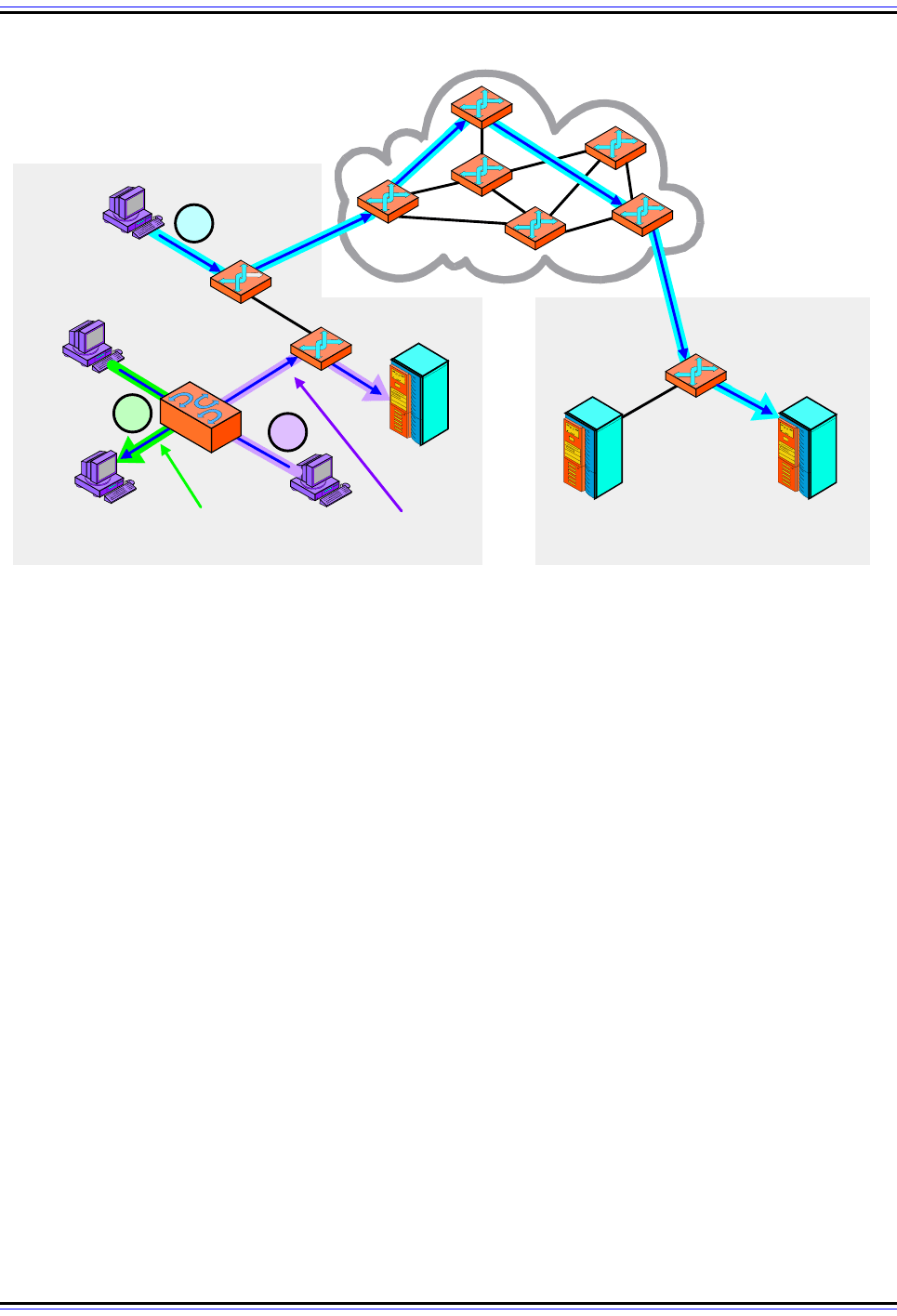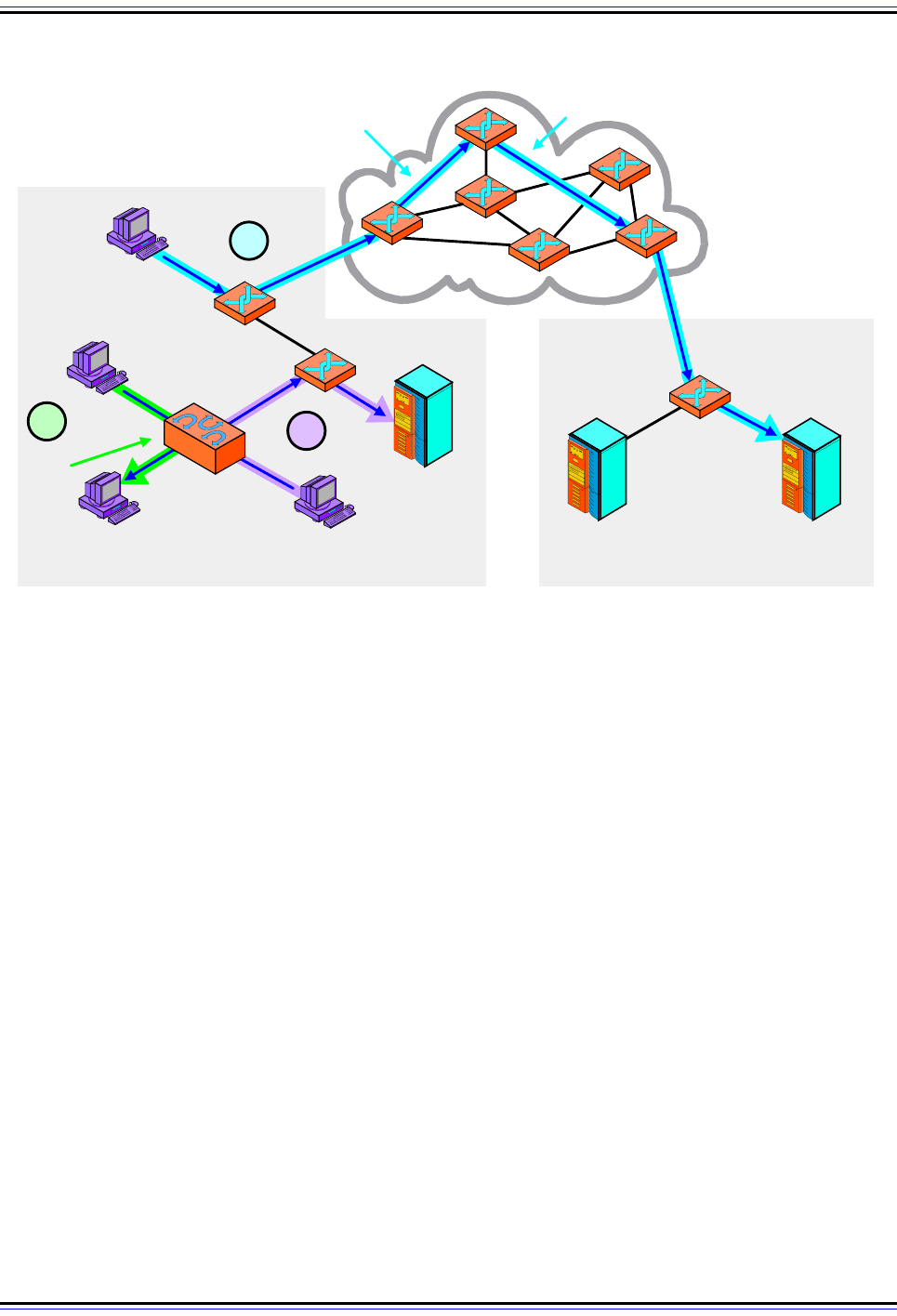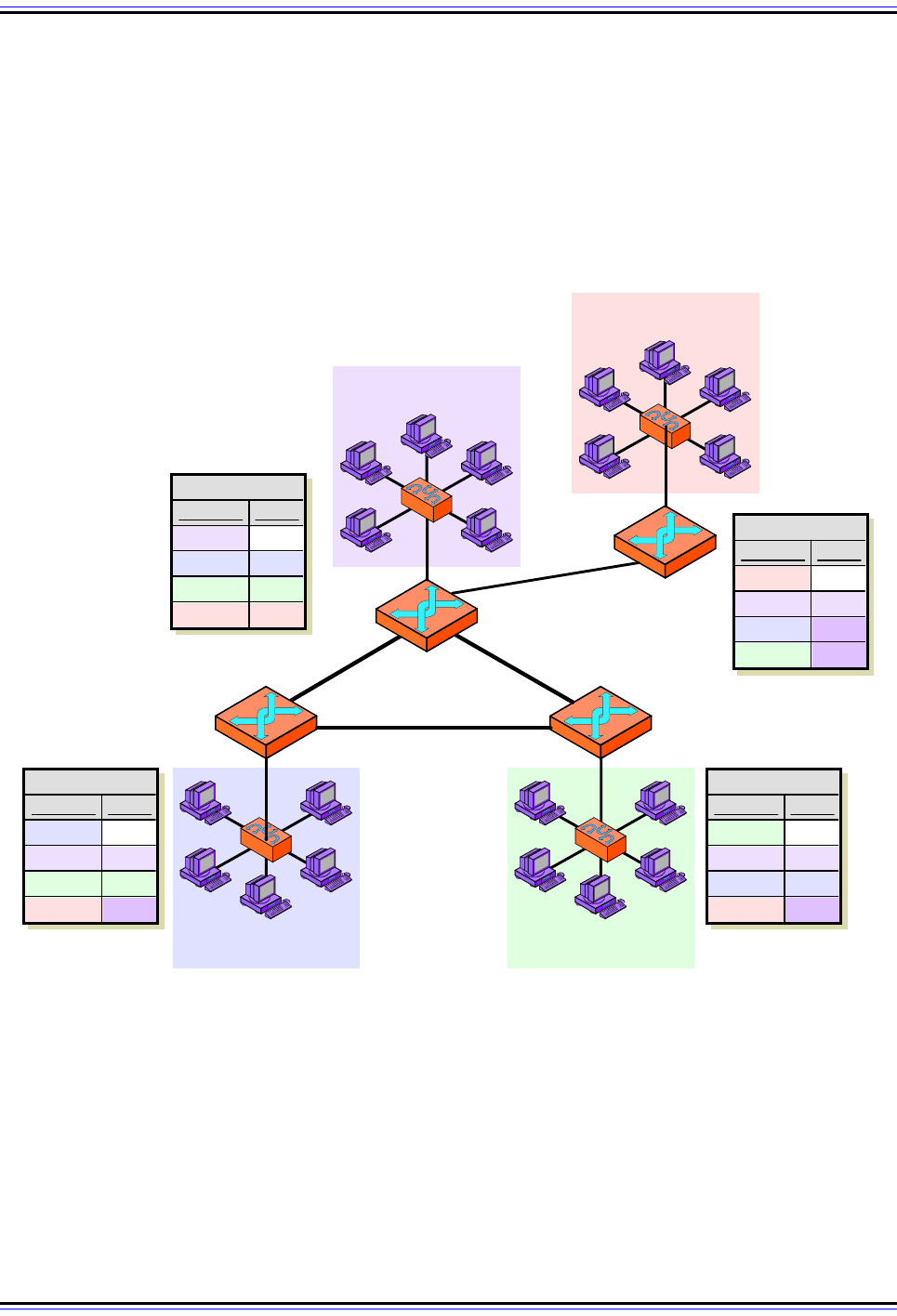Charles M. Kozierok The TCP-IP Guide
Подождите немного. Документ загружается.


The TCP/IP Guide - Version 3.0 (Contents) ` 441 _ © 2001-2005 Charles M. Kozierok. All Rights Reserved.
IP Datagram Delivery and Routing
The essential functions of IP datagram encapsulation and addressing are sometimes
compared to putting a letter in an envelope and then writing the address of the recipient on
it. Once our IP datagram “envelope” is filled and labelled, it is ready to go, but it's still sitting
on our desk. The last of the main functions of IP is to get the envelope from us to our
intended recipient. This is the process of datagram delivery. When the recipient is not on
our local network, this delivery requires that the datagram be routed from our network to the
one where the destination resides.
In this section I discuss some of the particulars of how IP routes datagrams over an inter-
network. I begin with an overview of the process and contrast direct and indirect delivery of
data between devices. I discuss the main method used to route datagrams over the
internet, and also explain briefly how IP routing tables are built and maintained. I discuss
how the move from “classful” to classless addressing using CIDR impacted routing.
Related Information: Note that this section is brief and focuses mainly on routing
issues that are directly related to how IP works. Routing is a complex and
important topic in networking, and you'll find much more information about it in the
section that discusses TCP/IP routing/gateway protocols. I have tried not to duplicate that
section by putting too much information about the process of routing here.
IP Datagram Direct Delivery and Indirect Delivery (Routing)
The overall job of the Internet Protocol is to transmit messages from higher layer protocols
over an internetwork of devices. These messages must be packaged and addressed, and if
necessary fragmented, and then they must be delivered. The process of delivery can be
either simple or complex, depending on the proximity of the source and destination devices.
Datagram Delivery Types
Conceptually, we can divide all IP datagram deliveries into two general types, shown graph-
ically in Figure 91:
☯ Direct Datagram Deliveries: When datagrams are sent between two devices on the
same physical network, it is possible for datagrams to be delivered directly from the
source to the destination. Imagine that you want to deliver a letter to a neighbor on
your street. You probably wouldn't bother mailing it through the post office; you'd just
put the neighbor’s name on the envelope and stick it right into his or her mailbox.
☯ Indirect Datagram Deliveries: When two devices are not on the same physical
network, the delivery of datagrams from one to the other is indirect. Since the source
device can't see the destination on its local network, it must send the datagram
through one or more intermediate devices to deliver it. Indirect delivery is analogous to

The TCP/IP Guide - Version 3.0 (Contents) ` 442 _ © 2001-2005 Charles M. Kozierok. All Rights Reserved.
mailing a letter to a friend in a different city. You don't deliver it yourself—you put it into
the postal system. The letter journeys through postal system, possibly taking several
intermediate steps, and ends up in your friend's neighborhood, where a postal carrier
puts it into his or her mailbox.
Comparing Direct and Indirect Delivery
Direct delivery is obviously the simpler of these. The source just sends the IP datagram
down to its data link layer implementation. The data link layer encapsulates the datagram in
a frame that is sent over the physical network directly to the recipient's data link layer, which
passes it up to the IP layer.
Indirect delivery is much more complicated, because we can't send the data straight to the
recipient. In fact, we usually will not even know where the recipient is, exactly. Sure, we
have its address, but we may not know what network it is on, or where that network is
relative to our own. (If I told you my address you'd know it's somewhere in Bennington,
Vermont, but could you find it?) Like relying on the postal system in the envelope analogy,
Figure 91: Direct and Indirect (Routed) Delivery of IP Datagrams
This diagram shows three examples of IP datagram delivery. The first transmission (highlighted in green)
shows a direct delivery between two devices on the local network. The second (purple) shows indirect delivery
within the local network, between a client and server separated by a router. The third shows a more distant
indirect delivery, between a client on the local network and a server across the Internet.
Host
LH2
Server
LS1
Server
RS1
Server
RS2
Router
R2
Router
R1
Router
RR1
Host
LH2
Host
LH3
Host
LH4
Remote NetworkLocal Network
Direct
Delivery
Indirect
Delivery
(Local)
Indirect
Delivery
(Internet)
#1
#2
#3
Internet
LAN
Switch

The TCP/IP Guide - Version 3.0 (Contents) ` 443 _ © 2001-2005 Charles M. Kozierok. All Rights Reserved.
we must rely on the internetwork itself to indirectly deliver datagrams. And like the postal
system, the power of IP is that you don't need to know how to get the letter to its recipient;
you just put it into the system.
The devices that accomplish this “magic” of indirect delivery are generally known as
routers, and indirect delivery is more commonly called routing. Like entrusting a letter to
your local mail carrier or mailbox, a host that needs to send to a distant device generally
sends datagrams to its local router. The router connects to one or more other routers, and
they each maintain information about where to send datagrams so that they reach their final
destination.
Indirect delivery is almost always required when communicating with distant devices, such
as those on the Internet or across a WAN link. However, it may also be needed even to
send to a device in the next room of your office, if that device is not connected directly to
yours at layer two.
Note: In the past, routers were often called gateways. Today, this term more
generally can refer to a device that connects networks in a variety of ways. You will
still sometimes hear routers called gateways—especially in the context of terms
like “default gateway”—but since it is ambiguous, the term router is preferred.
The Relationship Between Datagram Routing and Addressing
Obviously, each time a datagram must be sent, it is necessary that we determine first of all
whether we can deliver it directly or if routing is required. Remember all those pages and
pages of details about IP addressing? Well, this is where the payoff is. The same thing that
makes IP addressing sometimes hard to understand—the division into network ID and host
ID bits, as well as the subnet mask—is what allows a device to quickly determine whether
or not it is on the same network as its intended recipient:
☯ Conventional “Classful” Addressing: We know the class of each address by
looking at the first few bits. This tells us which bits of an address are the network ID. If
the network ID of the destination is the same as our own, the recipient is on the same
network; otherwise, it is not.
☯ Subnetted “Classful” Addressing: We use our subnet mask to determine our
network ID and subnet ID and that of the destination address. If the network ID and
subnet are the same, the recipient is on the same subnet. If only the network ID is the
same, the recipient is on a different subnet of the same network. If the network ID is
different, the destination is on a different network entirely.
☯ Classless Addressing: The same basic technique is used as for subnetted “classful”
addressing, except that there are no subnets. We use the “slash number” to determine
what part of the address is the network ID and compare the source and destination as
before. There are complications here, however, that I discuss more in the topic on
routing in a classless environment.

The TCP/IP Guide - Version 3.0 (Contents) ` 444 _ © 2001-2005 Charles M. Kozierok. All Rights Reserved.
Key Concept: The delivery of IP datagrams is divided into two categories: direct and
indirect. Direct delivery is possible when two devices are on the same physical
network. When they are not, indirect delivery, more commonly called routing, is
required to get the datagrams from source to destination. A device can tell which type of
delivery is required by looking at the IP address of the destination, in conjunction with
supplemental information such as the subnet mask that tells the device what network or
subnet it is on.
The determination of what type of delivery is required is the first step in the source deciding
where to send a datagram. If it realizes the destination is on the same local network it will
address the datagram to the recipient directly at the data link layer. Otherwise, it will send
the datagram to the data link layer address of one of the routers to which it is connected.
The IP address of the datagram will still be that of the ultimate destination. Mapping
between IP addresses and data link layer addresses is accomplished using the TCP/IP
Address Resolution Protocol (ARP).
I should also clarify one thing regarding the differentiation between direct and indirect
delivery. Routing is done in the latter case to get the datagram to the local network of the
recipient. After the datagram has been routed to the recipient's physical network, it is sent to
the recipient by the recipient's local router. So, you could say that indirect delivery includes
direct delivery as its final step.
The next topic discusses IP routing processes and concepts in more detail.
Note: Strictly speaking, any process of delivery between a source and destination
device can be considered routing, even if they are on the same network. It is
common, however, for the process of routing to refer more specifically to indirect
delivery as explained above.
IP Routing Concepts and the Process of Next-Hop Routing
When a datagram is sent between source and destination devices that are not on the same
physical network, the datagram must be delivered indirectly between the devices, a process
called routing. It is this ability to route information between devices that may be far away
that allows IP to create the equivalent of a virtual internetwork that spans potentially
thousands of physical networks, and lets devices even on opposite ends of the globe
communicate. The process of routing in general terms is too complex to get into in complete
detail here, but I do want to take a brief look at key IP routing concepts.

The TCP/IP Guide - Version 3.0 (Contents) ` 445 _ © 2001-2005 Charles M. Kozierok. All Rights Reserved.
Overview of IP Routing and Hops
To continue with our postal system analogy, I can send a letter from my home in the United
States to someone in, say, India, and the postal systems of both countries will work to
deliver the letter to its destination. However, when I drop a letter in the mailbox, it's not like
someone shows up, grabs the letter, and hand-delivers it to the right address in India. The
letter travels from the mailbox to my local post office. From there, it probably goes to a
regional distribution center, and then from there, to a hub for international traffic. It goes to
India, perhaps (likely) via an intermediate country. When it gets to India, the Indian postal
system uses its own network of offices and facilities to route the letter to its destination. The
envelope “hops” from one location to the next until it reaches its destination.
IP routing works in very much the same manner. Even though IP lets devices “connect”
over the internetwork using indirect delivery, all of the actual communication of datagrams
occurs over physical networks using routers. We don't know where exactly the destination
device's network is, and we certainly don't have any way to connect directly to each of the
thousands of networks out there. Instead, we rely on intermediate devices that are each
physically connected to each other in a variety of ways to form a mesh containing millions of
paths between networks. To get the datagram where it needs to go, it needs to be handed
off from one router to the next, until it gets to the physical network of the destination device.
The general term for this is next-hop routing. The process is illustrated in Figure 92.
The Benefits of Next-Hop Routing
This is a critical concept in how IP works: routing is done on a step-by-step basis, one hop
at a time. When we decide to send a datagram to a device on a distant network, we don't
know the exact path that the datagram will take; we only have enough information to send it
to the correct router to which we are attached. That router, in turn, looks at the IP address of
the destination and decides where the datagram should next “hop” to. This process
continues until the datagram reaches the destination host's network, when it is delivered.
Next-hop routing may seem at first like a strange way of communicating datagrams over an
internetwork. In fact, it is part of what makes IP so powerful. On each step of the journey to
any other host, a router only needs to know where the next step for the datagram is.
Without this concept, each device and router would need to know what path to take to every
other host on the internet, which would be quite impractical.
Key Concept: Indirect delivery of IP datagrams is accomplished using a process
called next-hop routing, where each message is handed from one router to the next
until it reaches the network of the destination. The main advantage of this is that
each router needs only to know which neighboring router should be the next recipient of a
given datagram, rather than needing to know the exact route to every destination network.

The TCP/IP Guide - Version 3.0 (Contents) ` 446 _ © 2001-2005 Charles M. Kozierok. All Rights Reserved.
Datagram Processing At Each Hop
As mentioned above, each “hop” in routing consists of traversal of a physical network. After
a source sends a datagram to its local router, the data link layer on the router passes it up to
the router's IP layer. There, the datagram's header is examined, and the router decides
what the next device is to send the datagram to. It then passes it back down to the data link
layer to be sent over one of the router's physical network links, typically to another router.
The router will either have a record of the physical addresses of the routers to which it is
connected, or it will use ARP to determine these addresses.
The Essential Role of Routers in IP Datagram Delivery
Another key concept related to the principle of next-hop routing is that routers are designed
to accomplish routing, not hosts. Most hosts are connected using only one router to the rest
of the internet (or Internet). It would be a maintenance nightmare to have to give each host
the smarts to know how to route to every other host. Instead, hosts only decide if they are
sending locally to their own network, or if they are sending to a non-local network. If the
Figure 92: IP Datagram Next-Hop Routing
This is the same diagram as that shown in Figure 91, except this time I have explicitly shown the hops taken
by each of the three sample transmissions. The direct delivery of the first (green) transmission has only one
hop (remember that the switch doesn’t count because it is invisible at layer three). The local indirect delivery
passes through one router, so it has two hops. The Internet delivery in this case has six hops; actual Internet
routes can be much longer.
Host
LH2
Server
LS1
Server
RS1
Server
RS2
Router
R1
Router
R2
Router
RR1
Host
LH1
Host
LH3
Host
LH4
Remote NetworkLocal Network
Hop
#1
Hop
#1
Hop
#2
Hop
#1
Hop
#2
Hop
#3
Hop
#4
Hop
#5
Hop
#6
#1
#2
#3
LAN
Switch

The TCP/IP Guide - Version 3.0 (Contents) ` 447 _ © 2001-2005 Charles M. Kozierok. All Rights Reserved.
latter, they just send the datagram to their router and say “here, you take care of this”. If a
host has a connection to more than one router, it only needs to know which router to use for
certain sets of distant networks. How routers decide what to do with the datagrams when
they receive them from hosts is the subject of the next topic.
IP Routes and Routing Tables
Routers are responsible for forwarding traffic on an IP internetwork. Each router accepts
datagrams from a variety of sources, examines the IP address of the destination and
decides what the next hop is that the datagram needs to take to get it that much closer to its
final destination. A question then naturally arises: how does a router know where to send
different datagrams?
Each router maintains a set of information that provides a mapping between different
network IDs and the other routers to which it is connected. This information is contained in a
data structure normally called a routing table. Each entry in the table, unsurprisingly called a
routing entry, provides information about one network (or subnetwork, or host). It basically
says “if the destination of this datagram is in the following network, the next hop you should
take is to the following device”. Each time a datagram is received the router checks its desti-
nation IP address against the routing entries in its table to decide where to send the
datagram, and then sends it on its next hop.
Obviously, the fewer the entries in this table, the faster the router can decide what to do with
datagrams. (This was a big part of the motivation for classless addressing, which aggre-
gates routes into “supernets” to reduce router table size, as we will see in the next topic.)
Some routers only have connections to two other devices, so they don't have much of a
decision to make. Typically, the router will simply take datagrams coming from one of its
interfaces and if necessary, send them out on the other one. For example, consider a small
company's router acting as the interface between a network of three hosts and the Internet.
Any datagrams sent to the router from a host on this network will need to go over the
router's connection to the router at the ISP.
When a router has connections to more than two devices, things become considerably
more complex. Some distant networks may be more easily reachable if datagrams are sent
using one of the routers than the other. The routing table contains information not only
about the networks directly connected to the router, but also information that the router has
“learned” about more distant networks.
Key Concept: A router make decisions about how to route datagrams using its
internal routing table. The table contains entries specifying to which router datagrams
should be sent to reach a particular network.

The TCP/IP Guide - Version 3.0 (Contents) ` 448 _ © 2001-2005 Charles M. Kozierok. All Rights Reserved.
Routing Tables in an Example Internetwork
Let’s consider an example (see Figure 93) with routers R1, R2 and R3 connected in a
“triangle”, so that each router can send directly to the others, as well as to its own local
network. Suppose R1's local network is 11.0.0.0/8, R2's is 12.0.0.0/8 and R3's is 13.0.0.0/8.
(I'm just trying to keep this simple. ☺) R1 knows that any datagram it sees with 11 as the
first octet is on its local network. It will also have a routing entry that says that any IP
address starting with “12” should go to R2, and any starting with “13” should go to R3.
Let's suppose that R1 also connects to another router, R4, which has 14.0.0.0/8 as its local
network. R1 will have an entry for this local network. However, R2 and R3 also need to
know how to reach 14.0.0.0/8, even though they don't connect to it its router directly. Most
Figure 93: IP Routing and Routing Tables
This diagram shows a small, simple internetwork consisting of four LANs each served by a router. The routing
table for each lists the router to which datagrams for each destination network should be sent, and is color
coded to match the colors of the networks. Notice that due to the “triangle”, each of R1, R2 and R3 can send
to each other. However, R2 and R3 must send through R1 to deliver to R4, and R4 must use R1 to reach
either of the others.
R1
R4
R1 Routing Table
Ne tw o r k Route
11.0.0.0/8 Dir ec t
12.0.0.0/8 R2
13.0.0.0/8 R3
14.0.0.0/8 R4
R2 Routing Table
Ne tw o r k Route
12.0.0.0/8 Dir ec t
11.0.0.0/8 R1
13.0.0.0/8 R3
14.0.0.0/8
R1
R3 Routing Table
Ne tw o r k Route
13.0.0.0/8 Dir ec t
11.0.0.0/8 R1
12.0.0.0/8 R2
14.0.0.0/8
R1
R4 Routing Table
Ne tw o r k Route
14.0.0.0/8 Dir ec t
11.0.0.0/8 R1
12.0.0.0/8
R1
13.0.0.0/8
R1
R2 R3
14.0.0.0/8
11.0.0.0/8
12.0.0.0/8 13.0.0.0/8

The TCP/IP Guide - Version 3.0 (Contents) ` 449 _ © 2001-2005 Charles M. Kozierok. All Rights Reserved.
likely, they will have an entry that says that any datagrams intended for 14.0.0.0/8 should be
sent to R1. R1 will then forward them to R4. Similarly, R4 will send any traffic intended for
12.0.0.0/8 or 13.0.0.0/8 through R1.
Route Determination
Now, imagine that this process is expanded to handle thousands of networks and routers.
Not only do routers need to know which of their local connections to use for each network,
they want to know, if possible, what is the best connection to use for each network. Since
routers are interconnected in a mesh there are usually multiple routes between any two
devices, but we want to take the best route whenever we can. This may be the shortest
route, the least congested, or the route considered optimal based on other criteria.
Determining what routes we should use for different networks turns out to be an important
but very complex job. Routers must plan routes and exchange information about routes and
networks, which can be done in a variety of ways. This is accomplished in IP using special
IP routing protocols. It is through these protocols that R2 and R3 would find out that
14.0.0.0/8 exists and that it is connected to them via R1. I discuss these important “support
protocols” in their own section.
Note: There is a difference between a routable protocol and a routing protocol.
IP is a routable protocol, which means its messages (datagrams) can be routed.
Examples of routing protocols are RIP or BGP, which are used to exchange
routing information between routers.
IP Routing In A Subnet Or Classless Addressing (CIDR) Environment
There are three main categories of IP addressing: “classful”, subnetted “classful”, and
classless. As we have already seen, the method used for determining whether direct or
indirect delivery of a datagram is required is different for each type of addressing. The type
of addressing used in the network also impacts how routers decide to forward traffic in an
internet.
One of the main reasons why the traditional class-based addressing scheme was created
was that it made both addressing and routing relatively simple. We must remember that
IPv4 was developed in the late 1970s, when the cheap and powerful computer hardware
we take for granted today was still in the realm of science fiction. For the internetwork to
function properly, routers had to be able to look at an IP address and quickly decide what to
do with it.
“Classful” addressing was intended to made this possible. There was only a two-level
hierarchy for the entire internet: network ID and host ID. Routers could tell by looking at the
first four bits which of the bits in any IP address were the network ID and which the host ID.
Then they needed only consult their routing tables to find the network ID and see which
router was the best route to that network.

The TCP/IP Guide - Version 3.0 (Contents) ` 450 _ © 2001-2005 Charles M. Kozierok. All Rights Reserved.
The addition of subnetting to conventional addressing didn't really change this for the main
routers on the internet, because subnetting is internal to the organization. The main routers
handling large volumes of traffic on the Internet didn't look at subnets at all; the additional
level of hierarchy that subnets represent existed only for the routers within each organi-
zation that chose to use subnetting. These routers, when deciding what to do with
datagrams within the organization's network, had to extract not only the network ID of IP
addresses, but also the subnet ID. This told them which internal physical network to send
the datagram to.
Aggregated Routes and their Impact on Routing
Classless addressing is formally called Classless Inter-Domain Routing or CIDR. The name
mentions routing and not addressing, and this is evidence that CIDR was introduced in
large part to improve the efficiency of routing. This improvement occurs because classless
networks use a multiple-level hierarchy. Each network can be broken down into subnet-
works, sub-subnetworks, and so on. This means that when we are deciding how to route in
a CIDR environment, we can also describe routes in a hierarchical manner. Many smaller
networks can be described using a single, higher-level network description that represents
them all to routers in the rest of the internet. This technique, sometimes called route aggre-
gation, reduces routing table size.
Let's refer back to the detailed example I gave in the addressing section on CIDR. An ISP
started with the block 71.94.0.0/15 and subdivided it multiple times to create smaller blocks
for itself and its customers. To the customers and users of this block, these smaller blocks
must be differentiated; the ISP obviously needs to know how to route traffic to the correct
customer. To everyone else on the Internet, however, these details are unimportant in
deciding how to route datagrams to anyone in that ISP's block. For example, suppose I am
using a host with IP address 211.42.113.5 and I need to send to 71.94.1.43. My local router,
and the main routers on the Internet, don't know where in the 71.94.0.0/15 block that
address is, and they don't need to know either. They just know that anything with the first 15
bits containing the binary equivalent of 71.94 goes to the router(s) that handle(s) 71.94.0.0/
15, which is the aggregated address of the entire block. They let the ISP's routers figure out
which of its constituent subnetworks contains 71.94.1.43.
Contrast this to the way it would be in a “classful” environment. Each of the customers of
this ISP would probably have one or more Class C address blocks. Each of these would
require a separate router entry, and these blocks would have to be known by all routers on
the Internet. Thus, instead of just one 71.94.0.0/15 entry, there would be dozens or even
hundreds of entries for each customer network. In the classless scheme, only one entry
exists, for the “parent” ISP.
Potential Ambiguities in Classless Routes
CIDR provides benefits to routing but also increases complexity. Under CIDR, we cannot
determine which bits are the network ID and which the host ID just from the IP address. To
make matters worse, we can have networks, subnetworks, sub-subnetworks and so on that
all have the same base address!
